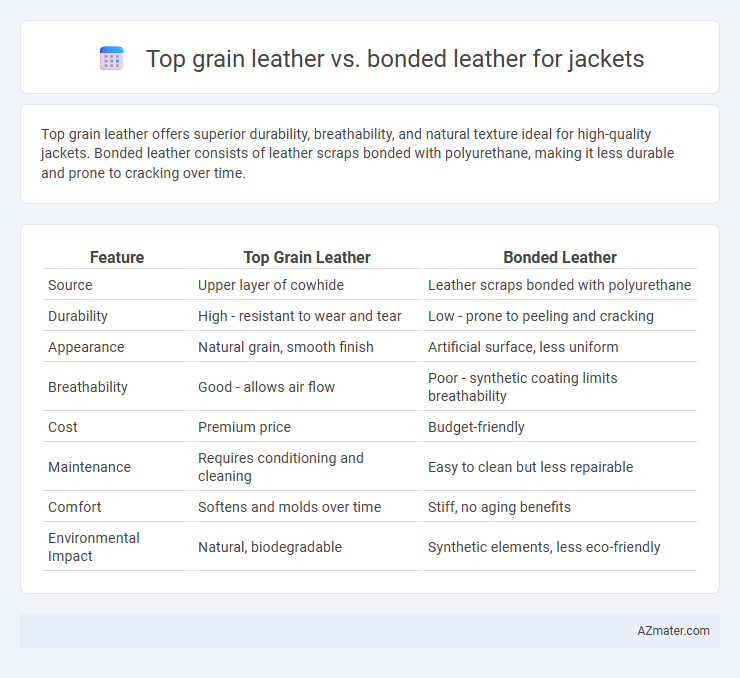Top grain leather offers superior durability, breathability, and natural texture ideal for high-quality jackets. Bonded leather consists of leather scraps bonded with polyurethane, making it less durable and prone to cracking over time.
Table of Comparison
| Feature | Top Grain Leather | Bonded Leather |
|---|---|---|
| Source | Upper layer of cowhide | Leather scraps bonded with polyurethane |
| Durability | High - resistant to wear and tear | Low - prone to peeling and cracking |
| Appearance | Natural grain, smooth finish | Artificial surface, less uniform |
| Breathability | Good - allows air flow | Poor - synthetic coating limits breathability |
| Cost | Premium price | Budget-friendly |
| Maintenance | Requires conditioning and cleaning | Easy to clean but less repairable |
| Comfort | Softens and molds over time | Stiff, no aging benefits |
| Environmental Impact | Natural, biodegradable | Synthetic elements, less eco-friendly |
Introduction: Understanding Leather Types for Jackets
Top grain leather offers durability and a natural grain surface that enhances breathability and aging, making it ideal for high-quality jackets. Bonded leather, composed of leftover leather scraps mixed with polyurethane, provides a budget-friendly option but lacks the strength and longevity of top grain leather. Choosing between these materials affects the jacket's comfort, appearance, and durability over time.
What is Top Grain Leather?
Top grain leather is premium-quality leather made from the outer layer of the animal hide, known for its durability, smooth texture, and natural grain patterns. It undergoes minimal sanding or buffing to retain strength while providing a polished and refined appearance, making it ideal for high-end jackets. Compared to bonded leather, which is made from leather scraps and fibers glued together, top grain leather offers superior breathability, longevity, and a more authentic leather experience.
What is Bonded Leather?
Bonded leather is a manufactured material made from shredded leather fibers mixed with polyurethane or latex, then bonded onto a fabric backing, offering a cost-effective alternative to genuine leather. It lacks the durability and natural texture of top grain leather, which is crafted from the upper layer of the animal hide and provides superior strength and breathability. While bonded leather jackets can mimic the appearance of real leather, they tend to wear out faster and are less breathable compared to top grain leather options.
Appearance and Aesthetic Differences
Top grain leather showcases a smooth, natural surface with unique grain patterns, offering a luxurious and authentic appearance ideal for stylish jackets. Bonded leather, made from shredded leather fibers bonded with polyurethane, presents a more uniform and synthetic look that often lacks the depth and character of genuine leather. The subtle texture and patina development over time in top grain leather significantly enhance its aesthetic appeal compared to the flatter, less durable finish of bonded leather jackets.
Durability and Longevity Comparison
Top grain leather jackets offer superior durability and longevity due to their natural grain surface, which is resistant to wear and develops a unique patina over time. Bonded leather jackets, made from shredded leather fibers bonded with polyurethane, tend to wear out faster, peeling and cracking with prolonged use. Investing in top grain leather ensures a jacket that maintains strength and aesthetic appeal for years, whereas bonded leather is more budget-friendly but less resilient.
Comfort and Wearability Factors
Top grain leather offers superior comfort and breathability due to its natural grain structure, making it highly durable and adaptable to body movements over time. Bonded leather, made from leather scraps bonded with polyurethane, tends to be less breathable and can become stiff, reducing overall wearability for prolonged use. Jackets crafted from top grain leather provide enhanced comfort and longevity, while bonded leather jackets may show wear and cracking more quickly under frequent wear conditions.
Cost and Value Analysis
Top grain leather jackets generally command higher prices due to their durability, natural texture, and superior breathability, offering long-term value through extended wear life and aging quality. Bonded leather jackets, made from shredded leather fibers bonded with polyurethane or latex, come at a significantly lower cost but lack the robustness and natural appearance of top grain leather, leading to quicker degradation and replacement costs. Evaluating cost versus value, top grain leather represents a more economical investment for frequent use, while bonded leather suits budget-conscious consumers prioritizing style over longevity.
Maintenance and Care Requirements
Top grain leather jackets require regular conditioning with suitable leather oils or creams to prevent drying and cracking, ensuring long-lasting durability and a natural patina. Bonded leather jackets demand more delicate care, as the composite material is prone to peeling and flaking when exposed to excessive moisture or harsh cleaning agents. Maintaining bonded leather involves gentle wiping with a damp cloth and avoiding prolonged sun exposure, while top grain leather benefits from periodic professional cleaning and conditioning to retain its strength and appearance.
Environmental Impact: Sustainability of Each Leather Type
Top grain leather, derived from the outer layer of animal hides, involves fewer chemicals and less energy-intensive processing, making it relatively more sustainable and durable in long-term use, which reduces waste. Bonded leather, composed of leather scraps bonded with synthetic materials and adhesives, often contains non-biodegradable components, resulting in higher environmental impact from production to disposal. Choosing top grain leather jackets supports sustainability through longevity and lower chemical pollution compared to the resource-intensive and less eco-friendly bonded leather alternatives.
Which Leather is Best for Jackets? Final Verdict
Top grain leather is the best choice for jackets due to its durability, natural texture, and ability to develop a rich patina over time, ensuring long-lasting wear and comfort. Bonded leather, made from leather scraps bonded with polyurethane or latex, lacks the strength and breathability of top grain leather, making it less suitable for jackets that require flexibility and resilience. For premium quality, longevity, and superior appearance, top grain leather stands out as the optimal material for leather jackets.

Infographic: Top grain leather vs Bonded leather for Jacket
 azmater.com
azmater.com